TL;DR
Put the TV in the nook, not above the fireplace. Keep the screen at seated eye level on a low console or within a built-in that brings the TV forward, and use the fireplace for art or a mirror. If glare from nearby windows is a concern, add a tilt/articulating mount and light-controlling window treatments. If you skip the TV, the nook is ideal for a dry bar, slim desk, or bookcase with closed storage below.
Introduction

Visualizing the living room nook versus fireplace debate with an overhead layout illustrating key sightlines and uses.
A shallow-but-wide living room nook can turn into the most argued-about square footage in a home. TV there, or TV over the fireplace? Storage or seating? It matters, because once you commit, you’re also committing to wiring, sightlines, and how the room actually lives. Here’s the thing: most of these alcoves were designed as media niches. I’ve seen homeowners discover the telltale signs - outlets and cable jacks clustered in the recess - and realize the builders made that call years ago. One homeowner told me they hung an 84-inch TV in their nook and never looked back. Another moved a TV off a high mantle after a month of neck strain and said movie night finally felt like, well, a night off. I’ve also seen the exact space used brilliantly as a dry bar with fluted doors, a slim desk with ottomans tucked beneath, and a punchy bookcase with concealed storage. The right answer depends on how you watch, how you walk through the room, and whether the fireplace should be the star or the supporting act.
Core Strategy and Direct Answer
Direct answer: put the TV in the nook and keep it at eye level. Use the fireplace for art, a mirror, or layered decor, not a screen. Why? Two reasons that trump everything else - ergonomics and proportion. How to execute it well:
- Mount height: aim to center the screen around seated eye level, roughly 40-44 inches from the floor for most sofas. That usually means the bottom of the TV lands about 20-28 inches off the floor on a low console or within a built-in.
- Viewing distance: for 4K TVs, a simple rule is 1.2-1.6 times the screen diagonal. A 65-inch TV feels great at about 6.5-8.5 feet.
- Bring the TV forward: if the nook is deep, build a shallow face frame or use a low-depth console that sits proud of the back wall so the TV aligns closer to the room. It looks intentional and helps with sound.
- Use a tilt or articulating mount: this lets you fine-tune angle and reduce glare. If a side window throws light, angle the screen slightly and add lined drapery or solar shades.
- Balance storage: closed base cabinets for components and clutter; open shelves above for books, plants, and a few personal pieces. Keep shelf depth 11-13 inches; base cabinets 18-24 inches.
- Keep paths clear: if there’s a walkway near the nook, maintain 36 inches of clearance behind seating. A slim console and thoughtful wire management keep it tidy.
- Fireplace focus: style the mantle with art and a picture light. Layer a tall vase or sculptural object to draw the eye without competing with the TV.
Anecdote
A homeowner once sent me a triumphant note after moving their TV from above a lofty mantle into the alcove. They said their shoulders dropped the second they sat down - no more craning - and their kids started reading on the hearth because the mantle finally hosted art instead of a black rectangle.
Common Mistakes and Misconceptions
- Mounting the TV over a high fireplace: Heat, height, and a cramped mantle zone are a bad trio. The angle forces you to look up more than 15 degrees, which causes fatigue. Fix: keep the TV in the nook and reserve the fireplace for art.
- Ignoring window glare: Placing a screen opposite or adjacent to a bright window without light control leads to washed-out images. Fix: solar shades or lined drapery, a matte-screen TV, and a tilt/articulating mount. Test at midday before drilling.
- Turning the niche into a deep bench: Shallow nooks rarely make comfortable loungers and often block circulation. Fix: choose purpose-built storage or a bar instead.
- Messy cables and components: Nothing dates a room faster than wires everywhere. Fix: run in-wall conduit, use CL2/CL3-rated cables, and stash gear in ventilated base cabinets with an IR repeater or mesh doors.
- Undersized furniture: A tiny console floating in a wide alcove looks accidental. Fix: fill the width with custom built-ins, or choose a longer low console with flanking shelves or tall plants for scale.
Pro Tips and Expert Insights
Designers’ playbook for a smart media niche:
- Add a shallow TV backer panel: A painted or wood panel set 1-2 inches off the wall hides cables and visually centers the TV. Paint it a darker tone to reduce perceived reflections.
- Plan for sound: Include a shelf for a soundbar just below the screen or wall-mount it with a bracket. Leave open space around speakers and vents for airflow.
- Architectural rhythm: If your fireplace has built-ins, echo their language in the nook - same door style, similar stile widths - but don’t mirror it perfectly. Slight asymmetry feels modern.
- Lighting layers: Add concealed LED strips under shelves, plus a small picture light over art on the mantle. Put shelf lights and sconces on a dimmer for movie-night mood.
- Future-proofing: Install a flexible conduit from the console to the TV location so upgrading cables in a few years doesn’t mean opening the wall.
Tools, Inspiration, and Recommended Resources
Try these low-lift helpers before you commit:
- Painter’s tape mockup: Tape the TV size and console height on the wall and sit for 10 minutes. If you look up to see the center of the “screen,” it’s too high.
- TV height calculators: Many AV guides offer simple calculators for ideal height and distance. They’re worth a quick check.
- Cable management kits: Look for in-wall rated power/HDMI kits and low-profile raceways painted to match the wall.
- Rapid visualization: Use ReimagineHome to test media wall, bar, or bookcase concepts on a photo of your space. It’s quick feedback before you start building.
- Ready-made consoles: Seek pieces 70-90 inches wide for wider alcoves, 20-24 inches high, with cord cutouts and adjustable shelves.
Visualization Scenario
Picture this: you walk in and see a calm, balanced room. The fireplace holds a large, softly lit painting. To the side, the alcove reads like custom millwork - a low bank of drawers, a dark backer panel, the TV floating at perfect height, and a few shelves with books and a trailing plant. No cables. No glare. The walkway stays open and the sofa faces the action. When the movie ends, the picture light glows and the room feels like a living room again, not a theater stuck on pause.
FAQ
- How high should I mount a TV in a living room? Center the screen at seated eye level, about 40-44 inches from the floor. Keep the viewing angle within 15 degrees up or down.
- What size TV works in a wide, shallow nook? Choose based on seating distance. At 7-8 feet, a 65-75 inch screen is comfortable for 4K. Fill remaining width with trim, shelves, or a backer panel so it looks built in.
- What if the fireplace is my focal point? Keep art or a mirror over the mantle and style it. Place the TV in the nook with low visual weight - dark backer, slimmer frame, concealed wires.
- How do I avoid glare from windows? Use tilt/articulating mounts, matte screens, and solar shades or lined drapery. Test at the brightest time of day before final placement.
- Could the nook be something else? Absolutely. A dry bar with closed storage, a slim desk with ottomans, or a full-height bookcase all work well if you don’t need the TV there.
Conclusion
If you want a room that wears well, put the TV in the nook at a comfortable height and let the fireplace be beautiful, not functional for media. Build in smart storage, manage glare, and light the mantle like art. If you truly don’t need a TV there, turn the space into a hardworking dry bar or slim desk and keep circulation clear. I’ll add one lived-in line: the best living rooms feel easy. You sit, you see, you reach, you relax. Design toward that feeling, and the decisions fall into place - debate settled.
.svg)

.svg)

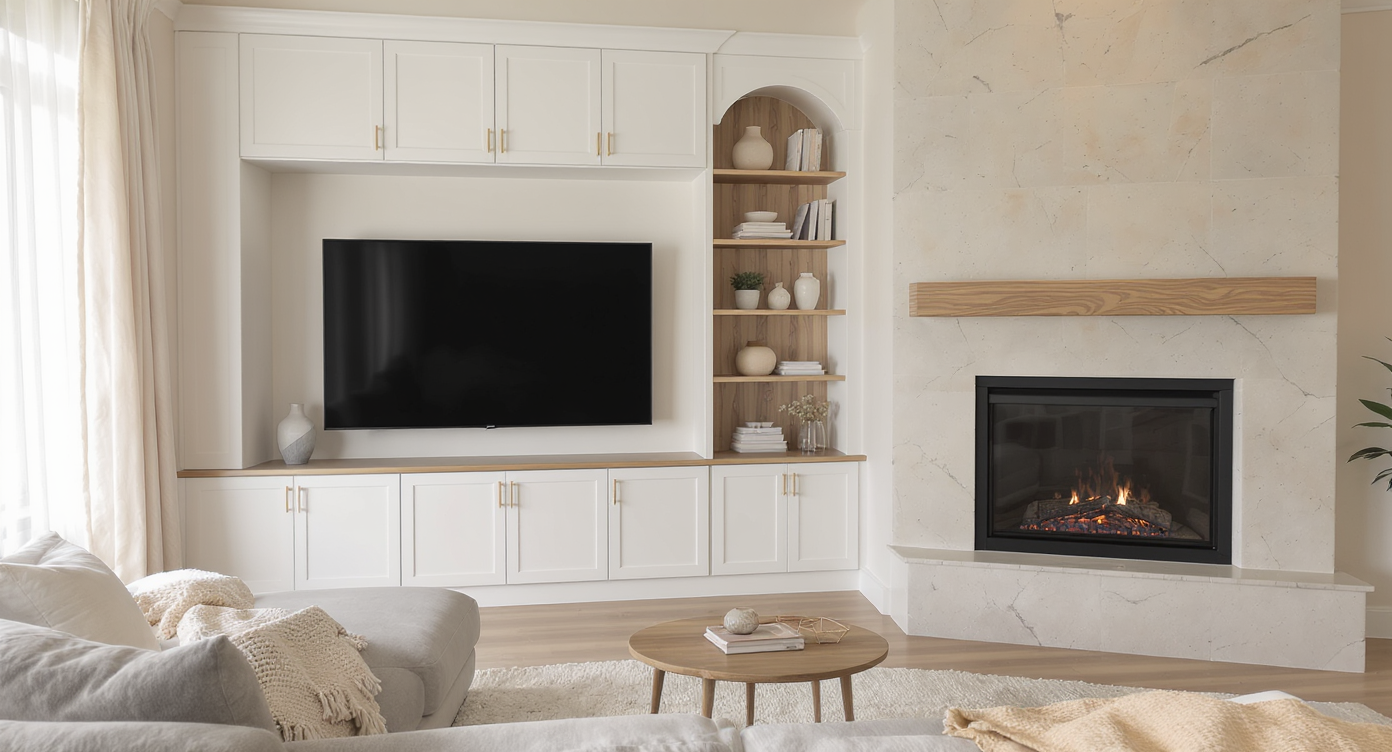
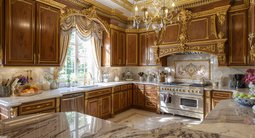
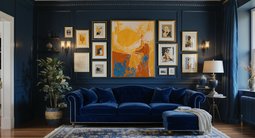

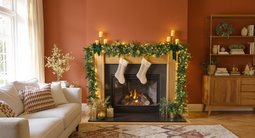
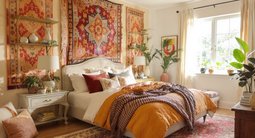
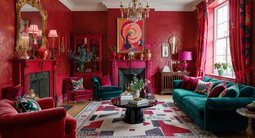


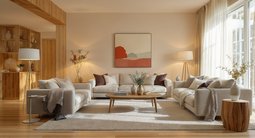
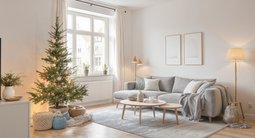


.png)